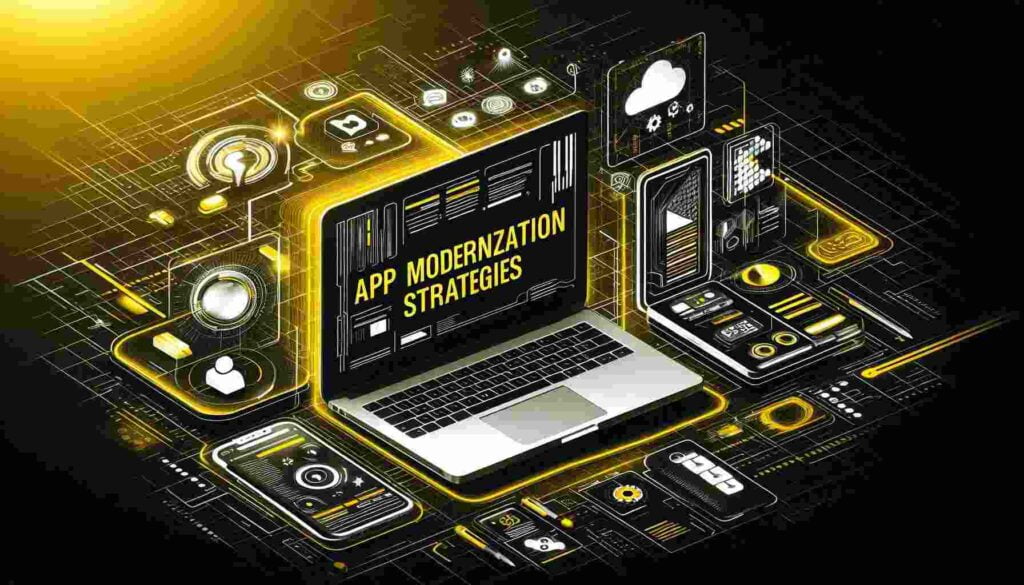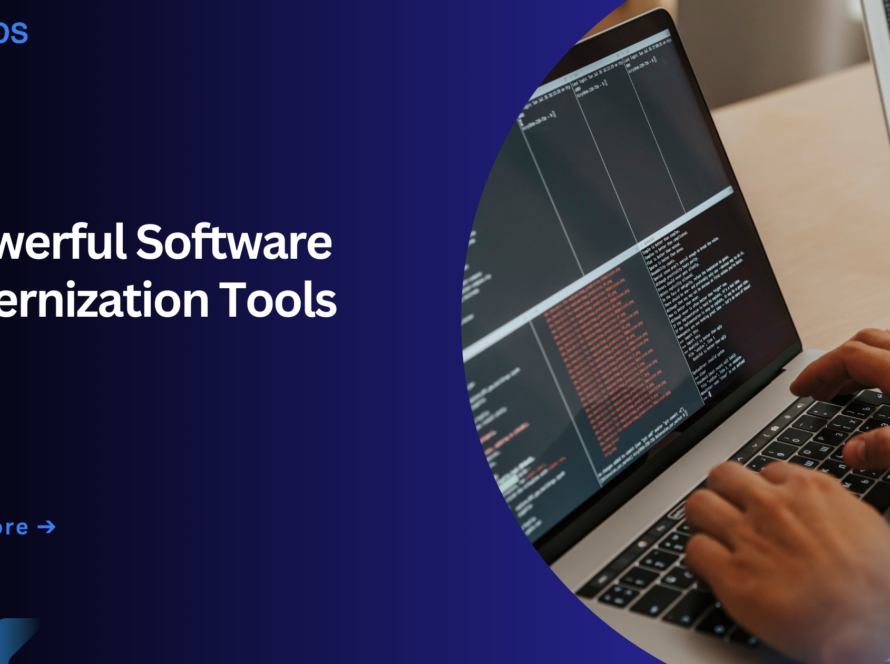Software Modernization is not just a luxury but a necessity for businesses striving to remain competitive and agile. The process involves updating legacy applications to new computing paradigms, architectures and technologies to improve performance, enhance user experience and reduce operational costs. Among the various approaches to app modernization, five primary Software modernization strategies stand out: Re-hosting, Re-platforming, Refactoring/Re-architecting, Rebuilding and Replacing.
In this blog, we will delve into each of these strategies, exploring their benefits, challenges and ideal use cases.
Table of Contents

Business Software Modernization Strategies:
1. Re-hosting (Lift and Shift)
Rehosting, generally referred to as “lift and shift,” is the process of moving an existing software to a new infrastructure environment without changing its architecture or source code. This strategy is the fastest and least expensive method to shift software to the cloud.
Benefits:
This process is pretty quick; rehosting lets a business shift to the cloud with very minimal disruption. It’s cost-effective, uses few resources and the up-front costs are pretty low compared to other modernization strategies. Because there is very little change to the software, this strategy almost eliminates the possibility of new bugs or other issues that might crop up with changes in the transition, thereby allowing the transition to take place much more easily and with much less disruption to the integrity of the original software. This ease and efficiency make re-hosting quite an appealing choice for any organization looking to modernize its infrastructure with a minimum of hassle and cost.
Challenges:
Rehosting, otherwise known as “lift and shift,” involves moving the software to a new infrastructure environment without changing the architecture or code-base of said software. This, however, brings about limitations to how quickly migration to the cloud is enabled with minimum hassle. Since the architecture remains identical, rehosting inhibits several opportunities for optimization and disallows full utilization of the cloud-native features. This leads to less-than-optimal performance and scalability since the software is unable to use the full power of the cloud environment. Moreover, rehosting does not touch any latent technical debt or structural issues of the software; this remain a future potential source of challenges and inefficiencies.
Applications where rapid shift to cloud is required simply for bringing down costs in data centers and to achieve the goal of re-hosting. This would also be rated as ideal in scenarios where minimal changes are wanted for the sake of business continuity.
2. Re-platforming
Re-platforming is when some minor changes are made to a software so that it makes more use of the cloud environment. Unlike re-hosting, re-platforming adjusts the software to make use of the cloud’s native features but without overall remodeling.
Benefits:
There are minor changes that achieve better performance, thus enabling the software to utilize cloud-native features such as managed databases and auto-scaling. More scalability of the software is also achieved through this enhancement, which helps the software bear increased workload and scale dynamically with demand. This also ensures long-term cost efficiency in resource usage for operational costs.
Challenges:
There is some moderate complexity as re-platforming requires some understanding of the existing software and how it works with the cloud environment. However, there might be minor changes in the software, which would require short bursts of downtime while migrating.
The best candidates for re-platforming are applications that require slight optimization to work better in the cloud and legacy systems that would use much of the Cloud-native features such as managed services and automatic scaling.
3. Refactoring/Re-architecting
This would then entail refactoring or the re-architecting of a deeper transformation of the code-base of software to fully leverage cloud-native capabilities. While this path is by far more complex and resource-intensive, it yields very substantial long-term benefits.
Benefits:
Refactored software provides optimal performance and efficiency, as it exploit cloud-native features to the fullest, including improved flexibility to change and extend software in line with evolving business needs. Cloud-native architectures, such as micro-services, connote seamless scalability of the software in handling larger workloads efficiently. These advantages position refactoring as an effective strategy for businesses to take full advantage of cloud technologies and ensure that their software stays adaptable to the changing demands and opportunities of the market.
Challenges:
It is a complex refactoring process, for it requires deep understanding of the software being moved and the cloud environment; hence, refactoring is pretty time-consuming. Compared to simpler strategies like re-hosting or re-platforming, it requires huge initial investment in terms of time, finances and resources.
On the other hand, drastic changes in the software may lead to disruptions and often introduce new problems that need rigorous testing and validation before they are released. Despite all these odds, the benefits are enormous for attaining optimal performance and scalability using cloud-native features; therefore, it is well worth the effort for any software that requires advanced optimization and flexibility.
The characteristics of refactoring make it best suited for software that requires future-proofing with high scalability and weed out enormous technical debt in the process. It is best applied, more particularly, when the system requires future-proofing and high scalability; it involves software projects where long-term performance and flexibility are major priorities.
Added to that, the highly complex nature of refactoring entails more than a substantial upfront investment in time, resources and expertise. This ensures that systems are as prepared for business changes and scaling as they could possibly be. Through the lessening of technical debt and optimization for cloud environments, refactoring drive a software to peak performance and competitive strength in these dynamic markets.
4. Rebuilding
Rebuilding, also known as “redesigning,” is based on the principle of complete trashing of the existing software code base and then developing a new software from scratch. In this approach, full deployment of state-of-the-art technologies and architectures will be possible in the new software.
Benefits:
Rebuilding a software guarantees full optimization because it will be designed without legacy constraints and will fit current and future needs. This will help in integrating modern features like AI, machine learning and advanced analytics, which further increase the capability and competitiveness of the software. Moreover, rebuilt software offers the best user experience since it complies with the modern principles of UI/UX, hence being more intuitive and user-friendly. While rebuilding is time- resource and expertise-intensive, the benefits are in future-proofing software and bringing it up to industry standards so that it sustain evolving business requirements and technological changes.
Challenges:
Incur huge costs and huge time commitment—only needed a huge investment in development resources and expenses. This changeover from the legacy software to the remade one is of a complex nature and requires careful planning in order to avoid loss of data and to keep operations running during the migration period. Besides, creating a new software from scratch brings with itself inherent risks like delays and unexpected technical hurdles impacting timelines and project outcomes. While there are challenges in the rebuild approach, it offers the opportunity to enrich capability enrichment for software, modern technologies and user experience, hence positioning it for long-term scalability and innovation.
Rebuilding of a software is necessary when the legacy system in question is so ancient or rigid that it cannot be successfully modernized by other strategies. It also applies in scenarios in which the business requires a completely new set of features and capabilities that existing software cannot support. In light of this, rebuilding becomes the choice for organizations aiming to create state-of-the-art software to give the latest technologies and deliver superior user experiences.
5. Replacing
Replacement stepping back from custom-built software to a COTS or SaaS solution could be applicable when a commercial solution better serve the business than a custom-built software.
Benefits:
Using a SaaS solution has several benefits for businesses. First of all, it reduces maintenance since these solutions are maintained and updated by the vendor itself, hence reducing the burden on internal IT teams. Second, SaaS solutions enable very fast time-to-deployment—normally with a minimum of configuration required before going live. This again makes the business very agile in implementing new functionalities without long development cycles. Finally, using SaaS reduces costs by avoiding in-house developments and connected continuous maintenance; hence, operational expenses are better forecasted and managed. The totality, therefore, is that SaaS solutions are imbued with a streamlined approach to software deployment and management that increases efficiency and scalability for the modern enterprise.
Challenges:
There are considerations to adopting commercial solutions. Other than reduced maintenance and faster time-to-market, they are accompanied by a number of limitations. The first and most important of these facts is that most commercial solutions have limited customization options compared to custom-built software, which are incapable of fully addressing specific business needs. Furthermore, dependence on a third-party vendor comes with potential risks whenever they change their product or go out of business altogether.
Data migration from legacy systems to commercial solutions is complex and requires proper planning in order to guarantee data integrity and continuity. However, commercial solutions remain an option for businesses targeting lean operations and cost efficiencies not bearing extensive in-house development.
Commercial solutions are particularly adequate for non-core software where customization would not be great. Commercial solution vendors find interest among organizations looking to rapidly integrate up-to-date functionalities, which involve a long development cycle. These platforms involve the seamless adoption of new features, keeping the internal overhead for maintaining custom software at a minimum. With the commercial route, resources stay focused on core activities, taking advantage of vendor-managed updates and support to derive benefits from increased operational efficiency and lower total cost. Here, trade-offs between the limitations introduced by customization have to be balanced against the value of rapid deployment and reduced maintenance.

Choosing the Right Strategy
The best strategy for modernization is the one that fits current conditions best, business goals, resources and schedules. Some tips to select the appropriate strategy are as follows:
- Assess the Current Software: Conduct a thorough evaluation of the existing software, identifying its strengths, weaknesses and areas for improvement.
- Define Business Goals: Clearly articulate the business objectives driving the modernization effort, such as improving performance, enhancing user experience, or reducing costs.
- Evaluate Resources: Consider the available budget, time and technical expertise. Some strategies, like refactoring, require significant investment, while others, like re-hosting, are less resource-intensive.
- Analyse Risks: Assess the potential risks associated with each strategy, including technical challenges, downtime and impact on users.
- Plan for the Future: Choose a strategy that aligns with the long-term vision of the organization, ensuring the modernized application is able to adapt to evolving business needs and technological advancements.
Software modernization is a critical process for organizations seeking to stay competitive and agile in today’s fast-paced digital landscape. By understanding and selecting the right modernization strategy, whether it be re-hosting, re-platforming, refactoring, rebuilding, or replacing, businesses are able to optimize their applications for performance, scalability and future growth. Each approach comes with its own set of benefits and challenges, making it of importance to carefully evaluate the specific needs and constraints of the organization. With a well-planned modernization strategy, companies not only preserve their existing investments but also uncover new opportunities for innovation and efficiency.
Himcos provides Business Software Modernization services. Our team isn’t just skilled, you get the best minds tackling your modernization project, ensuring exceptional quality and results. Our experts help improve performance, reduce costs, enhance security and foster innovation providing our clients with scalable, secure and high performing application



